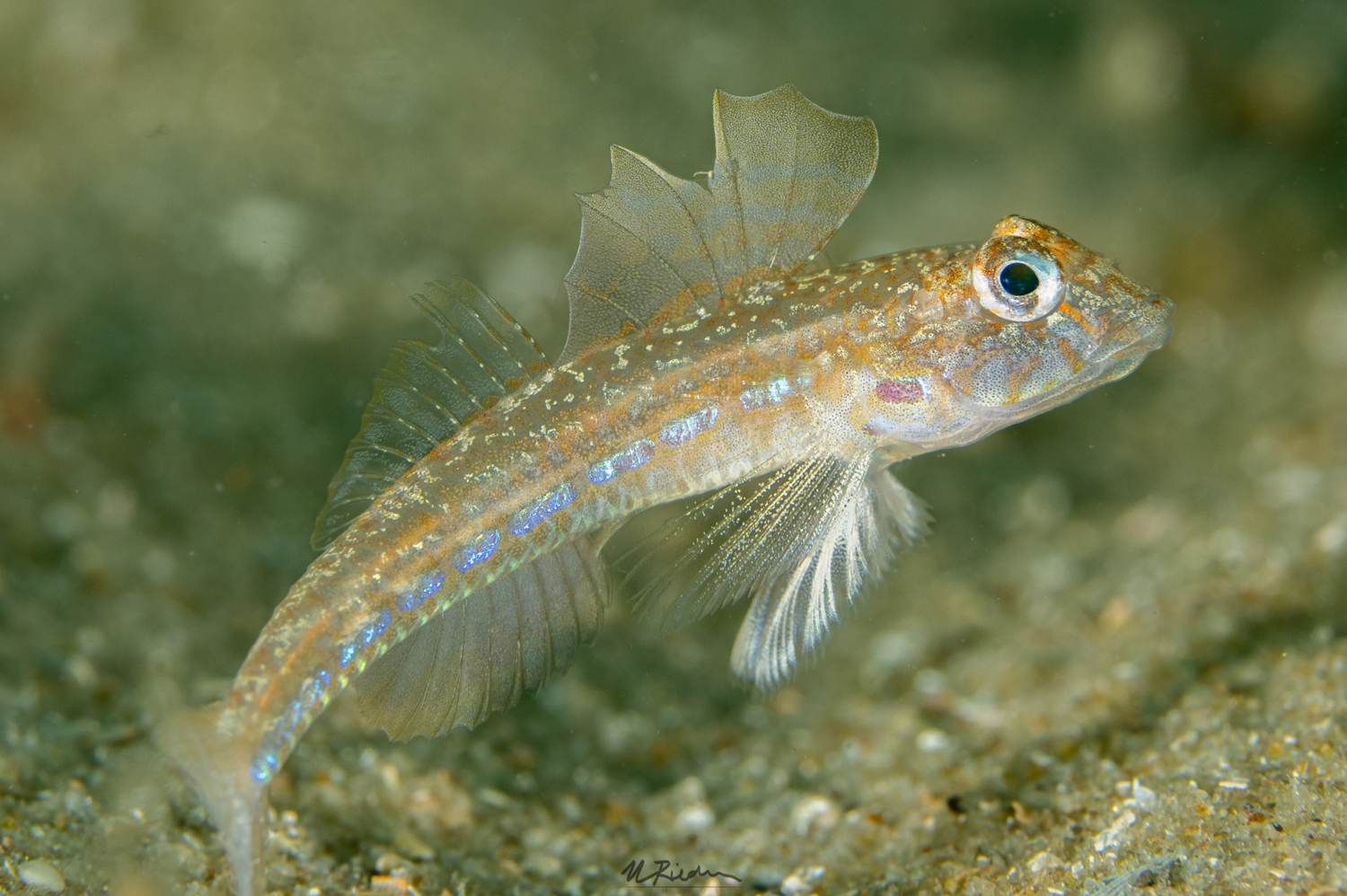- Classification
- ACTINOPTERYGII
- PERCIFORMES
- GOBIIDAE
- Nesogobius
- sp. 2 (of Hoese & Larson)
Threadfin Sandgoby, Nesogobius sp. 2 (of Hoese & Larson)

A Threadfin Sandgoby, Nesogobius sp. 2, at St Leonards, Port Phillip, Victoria, October 2023. Source: marciariederer / iNaturalist.org. License: CC by Attribution-NonCommercial
Summary:
An brownish sandgoby with small dark spots scattered on a sandy-brown head, a brown bar from the eye
to the middle of the jaw, pale blue dashes along the midsides with narrow vertical brown lines above and below the spaces between the dashes, and oblique rows of small orange and black spots on the dorsal fins. Males have elongate finrays at the rear of the dorsal fin.
Doug Hoese and Helen Larson are currently working on Nesogobius.
Doug Hoese and Helen Larson are currently working on Nesogobius.
Cite this page as:
Bray, D.J. 2018, Nesogobius sp. 2 (of Hoese & Larson) in Fishes of Australia, accessed 27 Jun 2025, https://fishesofaustralia.net.au/Home/species/5251
Threadfin Sandgoby, Nesogobius sp. 2 (of Hoese & Larson)
More Info
|
Distribution |
Endemic to southern Australia, from Wilson's Promontory, Victoria, to Kangaroo Island and the Gulf St Vincent, South Australia, and around Tasmania. Although this species occasionally occurs on sandy areas just beyond seagrass beds, most specimens have been taken in trawls in depths to 55 m. |
|
Features |
Dorsal fin VI + I, 8-9; Anal fin I, 8-9; Caudal fin (segmented rays) 13, (branched rays) 9; Pectoral fin 17-19; Pelvic fin I, 5; Gill rakers 0-2 + 6-8 = 7-9. Body slender. Head of moderate size (28-33% SL), broader than deep; interorbital narrow, eyes almost touching; mouth oblique, small, rear end of jaws below front quarter of eyes; sensory pores present by each nostril, sometimes median pore between front of eyes, sometimes median pore between rear end of eyes; pore behind upper quarter of each eye and pore behind middle of each eye; pore above rear end of each preopercular margin, no preopercular pores; gill openings broad, reaching forward to below and just before posterior preopercular margins; no groove behind posterior preopercular margin on each side; tongue tip truncate. Head naked; body scales ctenoid, in 26-30 vertical rows; anterior extent of scales at a line from upper pectoral fin insertions to second dorsal fin origin; midline of belly without scales; pectoral fin bases and area before pelvic fins without scales. Two dorsal fins, first dorsal fin small, higher anteriorly, with first spine longest first dorsal origin above pelvic fin insertions; second dorsal-fin origin just behind first dorsal fin; last ray in second dorsal fin often elongate in males. Anal fin origin below and just behind second dorsal origin. Caudal fin short, with truncate margin. Pectoral fins large, with rounded margin. Pelvic fins fused to form large cup-shaped disc, inserted just behind pectoral fin origins and reaching to anal fin origin. |
|
Size |
|
|
Colour |
Sandy brown head with numerous scattered small dark brown spots; area below eyes dark brown; irregular brown bar from each eye to middle of jaws; body with series of six to eight very small brown spots on midside, often with vertical thin brown lines extending ventrally from spots; horizontal broken thin white stripe just below midside; rear of caudal peduncle with a chevron-shaped brown mark, often broken into three spots at the apices of a triangle; dorsal fins with small orange and black spots forming oblique rows; enlarged black spot often in female at end of fin on membrane after last dorsal spine; anal fin clear to dusky; caudal fin clear, often with vertical wavy bands; pectoral and ventral fins clear to white; brown spot dorsally on each pectoral-fin base. |
|
Feeding |
|
|
Biology |
|
|
Fisheries |
|
|
Conservation |
|
|
Remarks |
|
|
Similar Species |
|
|
Etymology |
|
|
Species Citation |
|
|
Author |
Bray, D.J. 2018 |
|
Resources |
|
Threadfin Sandgoby, Nesogobius sp. 2 (of Hoese & Larson)
References
Hoese, D.F. & Larson, H.K. 1994. Family Gobiidae. pp. 781-810 in Gomon, M.F., Glover, C.J.M. & Kuiter, R.H. (eds) The Fishes of Australia's South Coast. Adelaide : State Printer 992 pp.
Hoese, D.F. & Larson, H.K. 2008. Family Gobiidae. pp. 749-773 in Gomon, M.F., Bray, D.J. & Kuiter, R.H. (eds) Fishes of Australia's Southern Coast. Sydney : Reed New Holland 928 pp.
-
Fish Classification
-
Class
ACTINOPTERYGII Ray-finned fishes -
Order
PERCIFORMES Perches and allies -
Family
GOBIIDAE Gobies -
Genus
Nesogobius -
Species
sp. 2 (of Hoese & Larson)


